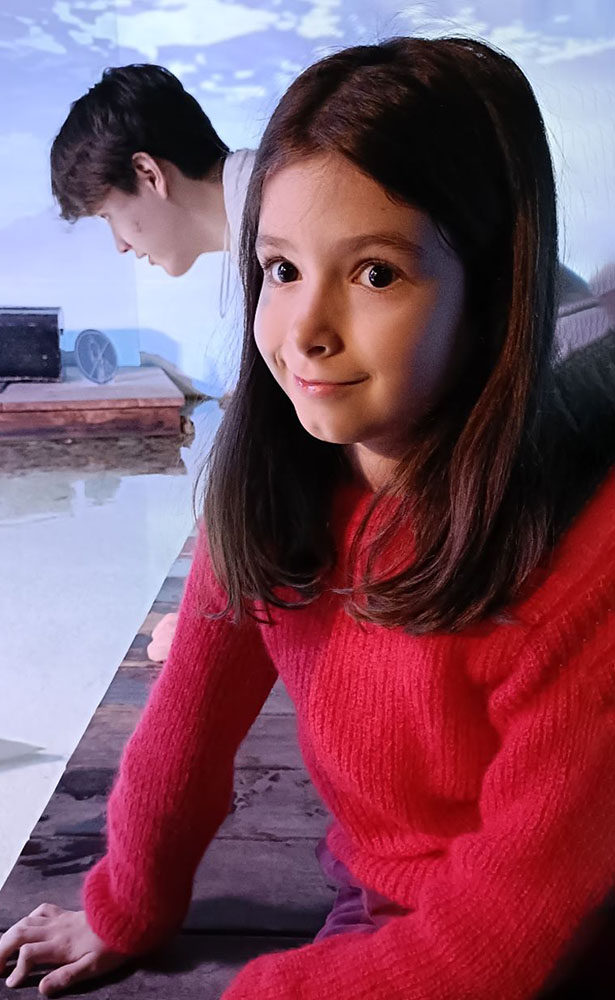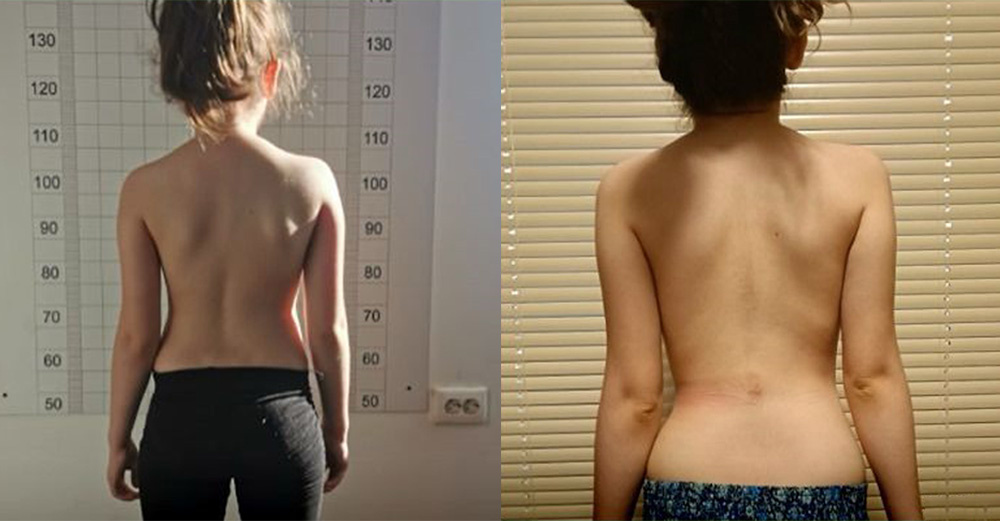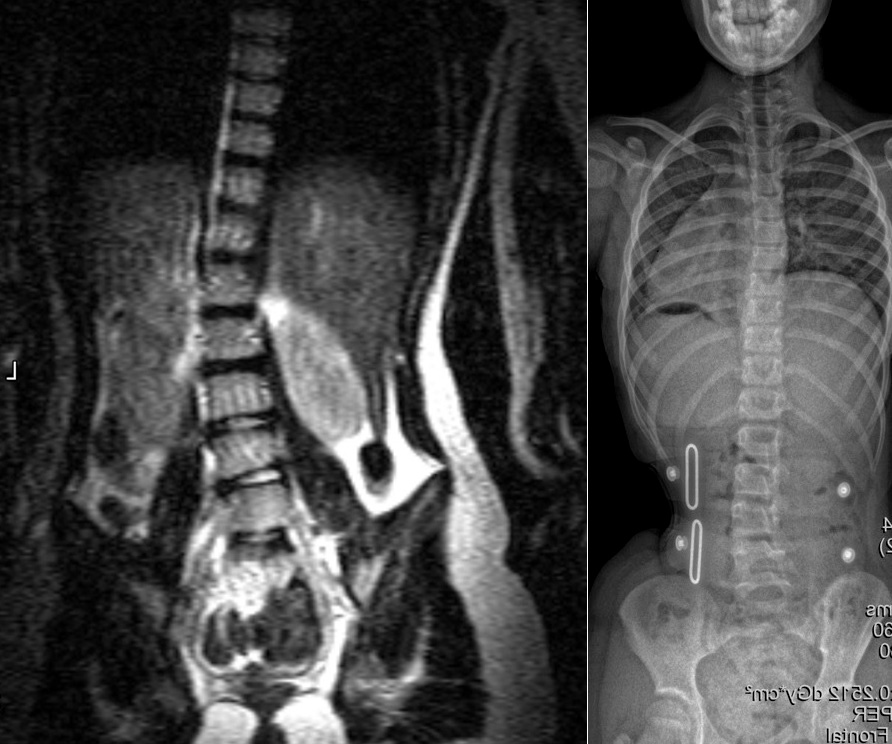
Iulia started her scoliosis bracing journey in Romania before coming to the London Orthotic Consultancy
08 January 2024
After previously trying out several scoliosis braces in Romania, Ukraine and Turkey, Iulia is already seeing results with the LOC Scoliosis Brace in a matter of months. Here, mum Raluca, describes how and why they came to LOC for her treatment.
“I became concerned about Iulia’s back almost two years ago when Iulia was 7 years old,” says mum Raluca. “I observed that she favoured certain postures, like sitting bent to the right, and when standing her body appeared tilted. I also noticed some issues with her balance and coordination. At the time I did not know anything about scoliosis, how it impacts someone’s health, or how fast it can progress if it appears at such a young age in the case of juvenile scoliosis.
I immediately went to a doctor in Bucharest, who diagnosed her with ‘postural scoliosis’ and told us that the approach in her situation was ‘to wait and see’. I asked if specific exercises could help and the answer was that in his experience he had not seen much improvement with exercising.
I was not happy with a wait-and-see approach and decided to do a bit of research about the kinesiotherapy (or ‘movement therapy’) centres in Romania that provided treatment for children with scoliosis. I chose one of them and scheduled an appointment for Iulia.

Left: Iulia before starting treatment and right, her spine looking visibly straighter after a few months of bracing treatment.
At that appointment, it was the first time anybody had suggested an x-ray to see what her spine looked like. They sent us for an orthospine x-ray, which I was reluctant to do, realising that the whole upper body will be exposed to radiation, and I considered that to be extremely harmful for such a young child. I realised though that an x-ray (or something similar) was important and looked for alternatives.
I came to learn about EOS x-rays, which expose the body to a significantly lower x-ray dose. This type of machine was not available in Romania, so I needed to search for it in nearby countries. I found one in Turkey, in Istanbul, and scheduled an appointment there.
After Iulia had the x-ray, the doctor let me know that her scoliosis was more serious than I expected, with a 25-degree Cobb angle on the lumbar spine and a compensatory curve on the thoracic spine. The diagnosis came as a shock, I did not expect it at all! I asked the doctor what I could do, and he told me pretty much the same thing as the first doctor in Bucharest, that historically the kinesiotherapy exercises do not help and given her Cobb angle - she was at the borderline for wearing a brace.
After long discussions with the doctor, we decided to go ahead with a scoliosis brace, which had to be worn for 22 hours per day. It was the first back brace I had ever seen, the Turkish doctor said it was a Cheneau-Gensingen type brace; it was made of very soft material. It took Iulia almost a week to get used to it, but overall the process was rather smooth. We came back to Bucharest with the brace, and Iulia started to do Schroth exercises four days a week.
Scoliosis is a condition where there is an abnormal curvature of the spine. It is a three-dimensional condition with deviation of the vertebrae in the sagittal, coronal and transverse planes.
Treatment recommendations are based on the Cobb angle of the patient and the risk of progression. For curves under 20 degrees, we monitor the patient’s curve while the patient undertakes a tailored exercise programme based on Schroth principles; this is delivered by our partner in providing scoliosis treatment, Scoliosis SOS.
For curves above 20 degrees, we prescribe our LOC Scoliosis Brace which works three-dimensionally to guide the patient’s spine into a more correct position, substantially reducing their Cobb angle. For optimum correction, we recommend that bracing is combined with specialist physiotherapy.
This joint approach means our patients are getting the best and most appropriate advice from two scoliosis specialists, one with an orthotic perspective and one with a physiotherapy perspective.
LOC makes the vast majority of orthotics we fit, and our scoliosis brace is no exception. It is difficult to over-emphasize how important it is to have our own manufacturing unit on site. Lead times are shorter because we are not reliant on outside suppliers, and we can fine-tune our braces at the fitting stage to ensure optimum efficacy and comfort.
The LOC Scoliosis Brace is a 3D, hypercorrective, Cheneau-Gensingen derivative brace, known as one of the most corrective and modern scoliosis braces available in the UK. It is designed to:
The brace is entirely unique and tailored to the patient’s spinal curve pattern, ensuring optimal skeletal correction while prioritising comfort.
Unlike traditional braces, it opens from the front for easier self-application and maintains a low profile under clothing.
The LOC Scoliosis Brace is worn 22 hours a day (including nighttime) and works in conjunction with Schroth-based therapy for maximum results.
Typically, there is an initial consultation followed by a fitting appointment and then pre- and post-reviews after in-brace x-rays; thereafter reviews every three months until the end of treatment. For the majority of our patients who are adolescents, we believe it is essential that there are regular assessments and reviews to ensure that the brace is fitting well; we will make tiny adjustments to the brace to ensure optimum comfort and optimum correction. We have found that comfort is a major contributor to an individual’s compliance with the prescribed wearing regime. In addition, the close contact between patient and clinician ensures patient motivation resulting in better outcomes at the treatment end.
We are pleased to offer a free-of-charge, virtual assessment should you wish to be screened for scoliosis. If we feel a referral to an Orthopaedic Consultant is warranted, we recommend a consultation at The Wimbledon Clinic, Parkside with Mr Darren Lui, Mr Jason Bernard or Mr Tim Bishop. The consultant would arrange the imaging as required. Obviously, you can also seek advice from your family GP.
I decided to work with two kinesiotherapy centres, one of them was quite far from our home and it was impossible to get there more than once per week, given Iulia’s school schedule and the heavy traffic in Bucharest. During her kinesiotherapy sessions, I noticed that there was a significant difference between the exercises she did at each of the centres, plus, the repetitions of the Schroth exercises just did not seem enough to me. It is not my area of expertise though, as I work in IT, so I decided to let the specialists do their job.
We continued with this exercise schedule and wearing the back brace for 22 hours per day without interruption and we were back in Turkey after 4 months for a review. The results were shocking. Iulia’s Cobb angle was now 30 degrees, and her hips appeared even more asymmetrical on the X-ray. They were so tilted that the first thing the doctor did was to measure her legs to see if they were of the same length; they were, so the worsening in her overall posture was attributed to scoliosis.
That was the moment I panicked. Out of desperation, I decided to enrol myself in the kinesiotherapy faculty, participate in as many Schroth specialisations as possible and work with Iulia at home. I also changed her brace, after getting more information about the available brace providers; we found one in Ukraine. Her new brace was a real Cheneau-Gensingen brace, and it visibly did a better job, but on the other hand, it was very heavy, made of solid plastic, and it was much more difficult for Iulia to get used to.
We gave up on working with the kinesiotherapy centers and I started to work with Iulia at home applying every bit of knowledge I had gleaned. Iulia, although very young, did an awesome job with participating fully in the physical therapy sessions and consistently wearing the brace.
Soon, in my journey to learn about scoliosis and how it can be treated, I found Scoliosis SOS. We started to work online with them and our therapists, Henry and Rosie, helped tremendously!
We started on the whole body strengthening, elongation and stretching exercise programme, along with specific Schroth exercises for straightening and de-rotating the spine. Their structured approach made a huge difference to Iulia’s overall posture and helped me understand a lot more about what a complete scoliosis exercise programme should look like.
In the meantime, Iulia went through a growth spurt, and her brace did not seem to fit anymore. Due to the war conditions in Ukraine, it was not an easy task for the brace provider to travel to Romania; so we began searching for a new brace provider again.
Following recommendations from our Scoliosis SOS therapists, we made an appointment with the London Orthotic Consultancy.
Everything went surprisingly smoothly, from the initial online consultation to the in-person appointment in London. I was pleasantly surprised by the clear explanations we got for every question, being a parent, it is important to have all the questions answered.
We offer a free virtual scoliosis appointment for those seeking scoliosis advice and treatment. This initial free virtual consultation is carried out through Skype, Facetime or Zoom.
During the appointment, you will have the opportunity to talk directly to one of our specialist clinicians about your child’s scoliosis. During this 15-minute appointment, your clinician will be able to answer any detailed questions or concerns you might have prior to booking a face-face assessment with us.
Anna Courtney, LOC’s clinical lead for scoliosis, was the specialist at LOC who saw Iulia. She spent time clarifying every little detail, plus, she made a point of discussing everything with Iulia herself and made her feel comfortable.
For the physical consultation, it was easy to travel to the London Orthotic Consultancy clinic in Kingston. Everything is very well organised, and the communication is awesome. I never sent an email which was not answered in the same day. They also provided guidance for our accommodation in London.
When I first saw the new scoliosis brace by LOC, I was literally shocked by how light it was. I thought that there was no way that the brace will work. Iulia was very happy about the brace; she told me that she almost did not feel it and that she finally could have a better night’s sleep.

Before and after scans of Iulia's back following several months of bracing treatment with the LOC Scoliosis Brace
After a week of Iulia wearing the brace, it became clear to me that the brace was doing a great job, judging by how straight Iulia’s back looked. It had never looked so straight before, I could hardly believe it! That was confirmed by the EOS in-brace x-ray in October, at her first review.
After a few months of wearing the LOC Scoliosis Brace, Iulia’s spine showed an in-brace correction of 100%, including the thoracic spine, although the brace is made only for the lumber spine.
As Iulia is only 9 years old, the most acute changes are expected to occur in the next few years. There are some years of treatment ahead but now I feel like we are way better prepared to face them, with a great scoliosis brace from LOC and a kinesiotherapy programme from Scoliosis SOS which perfectly fits Iulia’s needs.”
If you are worried that your child may have scoliosis or would like to know more about the LOC Scoliosis brace, you can book a free virtual appointment with one of our specialists.
If your child has recently been diagnosed with scoliosis or you think they are showing signs of the condition, please get in touch to book an appointment today.